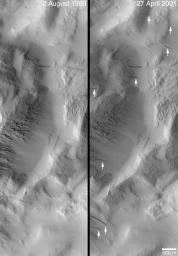
|
Changes Over a Martian Year – New Dark Slope Streaks in Lycus Sucli
- Click the image above for a larger view
- Full-Res JPEG (1044 x 1506) (256.2 kB)
- Full-Res TIFF (1044 x 1506) (1.6 MB)
Caption:
Now in its Extended Mission, Mars Global Surveyor (MGS) is into its second Mars year of systematic observations of the red planet. With the Extended Mission slated to run through April 2002, the Mars Orbiter Camera (MOC) is being used, among other things, to look for changes that have occurred in the past martian year. Because Mars is farther from the Sun than Earth, its year is longer--about 687 Earth days.
The two pictures shown here cover the same portion of Lycus Sulci, a rugged, ridged terrain north of the giant Olympus Mons volcano. The interval between the pictures span 92% of a martian year (August 2, 1999 to April 27, 2001). Dark streaks considered to result from the avalanching of dry, fine, bright dust are seen in both images. The disruption of the surface by the avalanching materials is thought to cause them to appear darker than their surroundings, just as the 1997 bouncing of Mars Pathfinder's airbags and the tire tracks made by the Sojourner rover left darkened markings indicating where the martian soil had been disrupted and disturbed. The arrows in the April 2001 picture indicate eight new streaks that formed on these slopes in Lycus Sulci since August 1999. These observations suggest that a new streak forms approximately once per martian year per kilometer (about 0.62 miles) along a slope.
In both images, north is toward the top/upper right and sunlight illuminates each from the left. Dark (as well bright) slope streaks are most common in the dust-covered martian regions of Tharsis, Arabia, and Elysium.
Cataloging Keywords:
| Name | Value | Additional Values |
|---|---|---|
| Target | Mars | |
| System | ||
| Target Type | Planet | |
| Mission | Mars Global Surveyor (MGS) | Mars Pathfinder (MPF) |
| Instrument Host | Mars Global Surveyor | |
| Host Type | Orbiter | |
| Instrument | Mars Orbiter Camera (MOC) | |
| Detector | ||
| Extra Keywords | Dust, Grayscale, Mountain, Volcano | |
| Acquisition Date | ||
| Release Date | 2001-05-24 | |
| Date in Caption | 1999-08-02 | 2001-04-27 |
| Image Credit | NASA/JPL/MSSS | |
| Source | photojournal.jpl.nasa.gov/catalog/PIA03226 | |
| Identifier | PIA03226 | |
